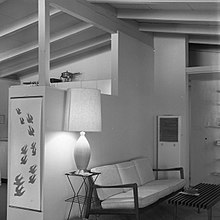Living room
This article needs additional citations for verification. (April 2012) |


In Western architecture, a living room, also called a lounge room (Australian English[1]), lounge (British English[2]), sitting room (British English[3]), or drawing room, is a room in a residential house or apartment for relaxing and socializing. Such a room is sometimes called a front room when it is near the main entrance at the front of the house. In large, formal homes, a sitting room is often a small private living area adjacent to a bedroom, such as the Queen's Sitting Room and the Lincoln Sitting Room of the White House. The term living room was coined in the late 19th or early 20th century.
Overview
In homes that lack a parlour or drawing room, the living room may also function as a reception room for guests.[4] Objects in living rooms may be used "to instigate and mediate contemplation about significant others, as well as to regulate the amount of intimacy desired with guests."[5]
A typical Western living room may contain furnishings such as a sofa, chairs, occasional tables, coffee tables, bookshelves, electric lamps, rugs, or other furniture. Traditionally, a sitting room in the United Kingdom and New Zealand has a fireplace, dating from when this was necessary for heating. In a Japanese sitting room, called a washitsu, the floor is covered with tatami, sectioned mats, on which people can sit comfortably.
From parlour to living room

The examples and perspective in this section may not represent a worldwide view of the subject. (April 2012) |
Until the late 19th century, the front parlour was the room in the house used for formal social events, including where the recently deceased were laid out before their funeral. The term "living room" is found initially in the decorating literature of the 1890s, where a living room is understood to be a reflection of the personality of the designer, rather than the Victorian conventions of the day.[6] Football on large color televisions caused larger family rooms to become more popular during the 1970s.[7] The change in terminology is credited to Edward Bok.
See also
References
- ^ "lounge room". OxfordDictionaries.com. Retrieved May 26, 2019.
- ^ "lounge". OxfordDictionaries.com. Retrieved May 26, 2019.
- ^ "sitting room". OxfordDictionaries.com. Retrieved May 26, 2019.
- ^ Martin, Judith (2003). Star-spangled manners: in which Miss Manners defends American etiquette (for a change). New York: W.W. Norton & Co. p. 264. ISBN 0-393-04861-6.
- ^ Rechavi, Talya B. (March 2009). "A Room for Living: Private and Public Aspects in the Experience of the Living Room". Journal of Environmental Psychology. 29 (1): 133–143. doi:10.1016/j.jenvp.2008.05.001.
- ^ Halttunen, Karen (1989). "From Parlor to Living Room: Domestic Space, Interior Decoration, and the Culture of Personality". In Bronner, Simon (ed.). Consuming Visions: Accumulation and Display of Goods In America 1880–1920 (1st ed.). New York: Norton. ISBN 0-393-02709-0. OCLC 756964793.
- ^ "TV, football affects home living, layout". Tucson Daily Citizen. UPI. August 6, 1973. p. 20. Retrieved September 7, 2015 – via Newspapers.com.

External links
 Media related to Living rooms at Wikimedia Commons
Media related to Living rooms at Wikimedia Commons
